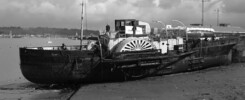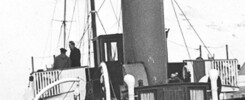Capt R “Bob” Hayman
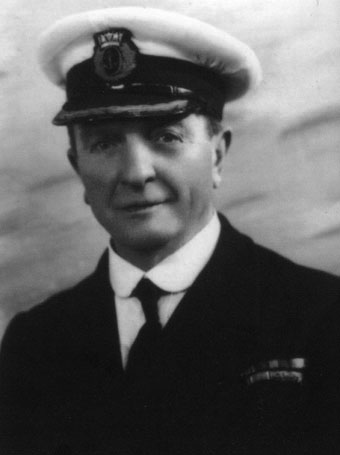
My father was given an introduction to Bob Hayman (as he was known to nearly everyone) and in the early 1930s took me to meet him on the PS Medway Queen from Southend where we lived. We had watched the Medway Queen from the end of Southend Pier embarking and disembarking passengers but had not travelled on it before. We were welcomed aboard at Southend Pier after my father had introduced himself to Bob Hayman and when the ship had sailed on the way to Herne Bay, the Captain showed us round the ship and introduced us to the Chief Officer and Chief Engineer. My father then suggested that he would like to buy Bob Hayman a drink. It was quite normal in those days for Captains and Officers to be seen having a drink in the bar. Before they went to the bar Bob Hayman took me up on to the bridge and left me with the Chief Officer who told me about navigating the ship and his other duties on board. This became our routine whenever we went on the ship and as I got older into my teens I was sometimes allowed to take the wheel and steer the Medway Queen. I remember Bob Hayman saying to me as we made our way along the Kent Coast ‘put her nose on the water tower Jack’ This is located at the back of Herne Bay and a prominent landmark. Bob Hayman called me Jack instead of John as he said Jack was a proper sailor’s name.
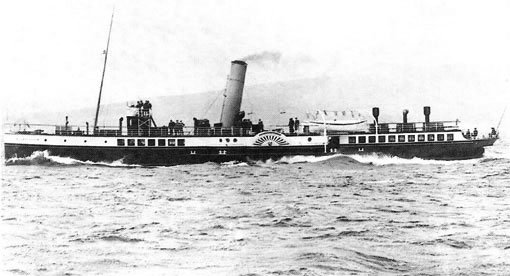
Captain Hayman was a Master with the original Medway Steam Packet Co and became Master of Captain Shippick’s paddle steamer Audrey when the New Medway Steam Packet Co was formed in 1922. He joined the Medway Queen as relief Master when the ship was brought down from the Clyde in 1924 by the senior Master, Captain Scott, after her trials. Bob Hayman took command of the ship a year or so later when Captain Scott retired from NSMPC and Hayman remained with Medway Queen until war broke out in 1939. He then retired, but was brought out of retirement later during the war as Chief Officer with his friend and colleague Captain Alf Aldis who had become Master of the Essex Queen which had been converted into a hospital ship operating on the Thames and Medway. At the end of the war in 1945 Bob Hayman was again involved with Alf Aldis when the Essex Queen was sold to a new company to run excursions from Torquay. He and Aldis were to take the ‘Essex Queen’ down to Torquay, but sadly Hayman died before this could be arranged.
My last memory of Bob Hayman when we were on board a few days before war was declared in September 1939. He pointed out to us the Navy minelayers operating quite near us and saying that he had orders from the Navy to adhere strictly to the pilotage channels, ‘I can’t take any short cuts today’ he said. Unknown to me at the time, this was to be our last trip together as my father died during the War and Bob Hayman died shortly after the end of the War before the Medway Queen was returned to peacetime service when Len Horsham became Master.
Capt Tommy Aldis DSC
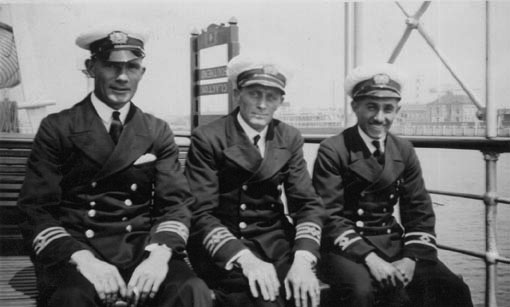
In the late 1920’s Tommy Aldis was Master of the ex HMS Melton which was renamed the PS Queen of Thanet which ran mostly on the Continental service from the Medway via Southend and Margate to Calais and Boulogne. Tommy Aldis was one of the best Masters of the NMSPC fleet and I had not realised at the time that he had become the company’s Senior Master.
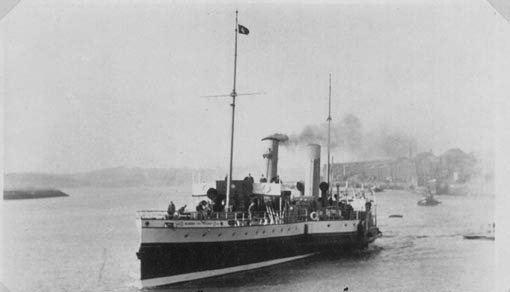
Captain Shippick had noticed his potential in 1915 when he and his brother Alf were taken on by Shippick as young deck hands on the PS Audrey when the ship was part of the ferry service which Captain Shippick was operating during the War on behalf of the Navy on the Medway carrying naval and civilian personnel between Chatham to Sheerness. Shippick had encouraged both of them to go deep sea to get experience and qualifications to become officers. This they did, and later returned to the NMSPC and in time became Masters with Captain Shippick’s new company.
I didn’t know him personally until after he had retired when in 1966 I was a guest of Don Rose on the first voyage of the PS Queen of the South from Tower Pier and he was also a guest on board and Don Rose introduced me to him. I remembered him from my school days when I used to go to the end of Southend Pier and spent many hours watching how the various Captains handled their ships in different tides and weather conditions when berthing at the pier head. It was surprising how varied they could be. In those days of intense competition between the companies, timing at the piers was crucial in getting passengers on and off as quickly as possible. Mostly four gangways were put ashore, and, depending on the numbers, two for embarking and two for disembarking.
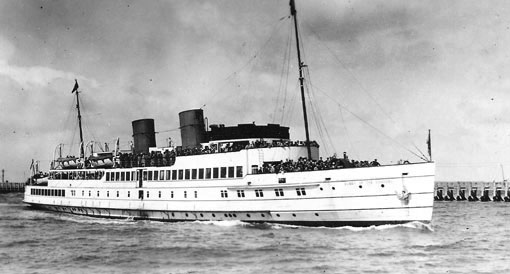
In 1935 he became the first Master of the pioneering motor vessel Queen of the Channel and it was on this ship that I made my first Continental trip to Ostend with my father. We were both greatly surprised by the luxurious saloons and bars compared with the old paddle steamers. In 1936 Tommy Aldis took the ship from the Medway round to Southampton with passengers to see the start of the maiden voyage of the RMS Queen Mary calling at Brighton for a night in an hotel en route.
Sadly Tommy Aldis resigned from the company in 1938 in protest at the company becoming a subsidiary GSN and his consequent loss of seniority. Other Captains were happy with the takeover as it meant that in the winter months they transferred to the cargo fleet instead having to work in Acorn Yard. He then took a shore job as Harbour Master at Margate, but resigned after a year and returned to NMSPC/GSN when World War 2 broke out and became Master of the MV Royal Sovereign which was then doing duty as a troop carrier, replacing his brother Alf Aldis. Alf then took over the PS Essex Queen, which had been converted into a hospital ship mainly plying on the Thames & Medway.
In December 1940 the Royal Sovereign which had been taken over by the Navy from the Ministry of Transport and was on her way from the Gareloch to the South of England and whilst calling in the Bristol Channel with a local pilot on board for bunkering the ship hit a mine in a supposedly swept channel and began to sink. The Chief Officer was killed by falling concrete slabs from the roof of wheelhouse and Aldis and the pilot were also on the bridge and injured by the explosion. Despite his injuries Aldis managed to get below, although the companionways were demolished, and was able to help some of the crew onto a tug which had come alongside to assist the ship while she was sinking.
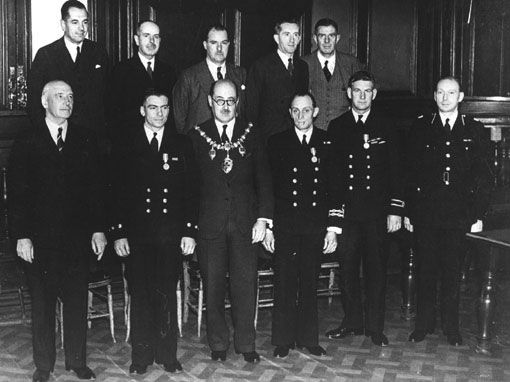
Capt Aldis was awarded the DSC and the Lloyds Bravery Award for his actions in this tragedy. This picture shows him in the front row third from the right on the occasion of receiving the latter. Capt Shippick is in the front row on the extreme left.
When the war ended he returned to the NMSPC fleet and in 1946 when I made the first sailing after the War from Tower Pier to Southend I was delighted to find him in command of his old ship the PS Queen of Thanet. In 1949 he took command of the replacement for the MV Queen of the Channel and later was able to take the ship once more on the Continental Service. He took early retirement from the NMSPC/GSN in the 50’s but could still be seen occasionally helping out with a well known Medway tug company. In the mid 60’s he was involved with Don Rose with the manning of the PS Queen of the South during the second and ill fated last season of the ship in 1967.
Capt A Paterson DSC
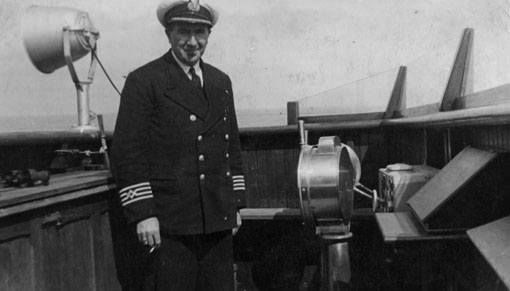
I became friendly with Captain Paterson purely because he spoke to me one day while he was walking about the decks saying that he had noticed how often I was on his ship and asking how I had so much spare time. I told him that I worked for the BBC and was on shift work, at which he asked me to come up on the bridge and tell him about the BBC. From then onwards we became friends and I found he was quite a different Master from the others on the summer service as he was most sociable. Often six or more of his friends joined him on the bridge while crossing the channel on her regular ‘non landing’ French Coast cruise and usually held very jolly tea parties on the bridge and in his cabin. I found out later these parties were not at all popular with “Taffy” Howell the Chief Officer at the time, who ran the ship very efficiently while Captain Paterson entertained his friends. Captain Johnson on his days off from Piloting would sometimes bring his wife on board and join in the parties on the bridge. I should mention that Chief Officer Howell later on became Master of the GSN troop carrying ship the Empire Wansbeck sailing from Harwich.
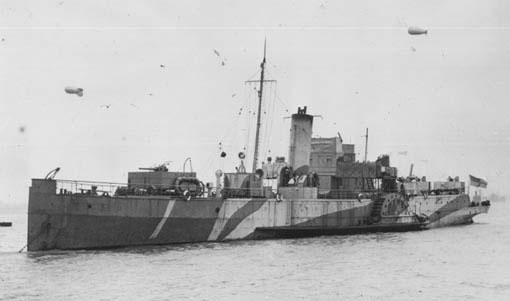
Captain Paterson was a Chief Officer with the GSN cargo fleet and in 1938 he and Captain Johnson joined the summer service and took over the New Medway Steam Packet Queen of Southend which had been renamed that summer to PS Thames Queen. I remember Captain Paterson telling me that he and Johnson had quite a job bringing the Thames Queen up to the standard required of a GSN summer service ship. This renaming was necessary to cover the General Steam Navigation Co charter by the Port of London Authority for their London dock cruises from Tower Pier on Thursday, Friday and Saturday. On other days Sunday, Monday and Tuesday the ship was back on her old scheduled run to Clacton, Walton & Felixstowe from London, calling also at Southend en route. This is one of the major changes following the merger/takeover of the NMSPC and GSN summer fleets.
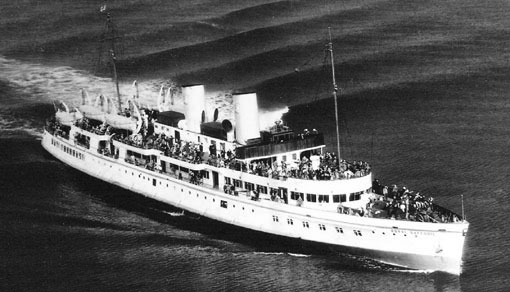
The combination of Paterson and Johnson obviously impressed GSN Directors and their Marine Superintendent as they were chosen to take over the brand new MV Royal Daffodil in 1939 in her first season on the Thames/Continental Service. When War broke out in September 1939 Paterson & Johnson remained with the Royal Daffodil and first of all joined the rest of the NMSPC/GSN fleet in evacuating school children from London to East Anglia. After that the motor vessels were mainly used by the Ministry of Transport carrying members of the British Expeditionary Force across the English Channel to France. In 1940 Royal Daffodil took part in the Dunkirk evacuation and carried over 9,000 troops back to the UK, during which time the ship was hit by a bomb which damaged her but fortunately did not explode. From then onwards for most of the War they spent running on the Stranraer/Larne (LMS service) and carried over two million passengers across this hazardous part of the Irish Seat without any incidents. In recognition of their War Service they were both awarded the DSC.
In 1947 after the RD had been refurbished by Dennys, Paterson was appointed Master of the ship for her peacetime excursion work as Johnson had left the company and joined the Thames Pilotage service. In 1950 the RD made a special 10th anniversary sailing to Dunkirk and passengers holding passports were allowed ashore for a Special Service at Dunkirk. Many notable Masters and company officials were on board including ex Commodore Branthwaite, the renowned Master of the PS Royal Eagle who had retired at the end of the War, and I was at last able to be introduced to him by Captain Paterson when he visited the bridge and I found him most affable and so pleasant to chat to and hear him talk about his days at sea.
Captain Paterson in the mid 1950’s sadly had to give up the summer service due to ill health aggravated by the long periods of standing while on duty. He returned to the cargo fleet, but died a few years later. He was succeeded by Captain Kitto, another one of Shippick’s ex NMSP Masters .He was a member of the RNVR and was called up in 1939 and had a very successful naval wartime career. Under him the days of bridge parties were over and the RD was run very much in strict naval tradition.
Capt Leonard Horsham
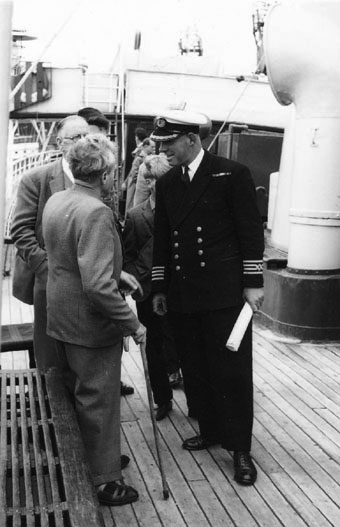
Captain Leonard Horsham was another of Shippick’s ‘boys’. I have been told that he started in the late 20’s by selling chocolates around the decks of various NMSPC ships but he soon joined as a member of the deck crew and worked aboard while studying for his tickets. He eventually became Chief Officer with Captain Tommy Aldis on the new MV Queen of the Channel in 1935. Two years later he became one of the youngest Captains of the fleet when he took over as Master of the PS City of Rochester and mainly ran the ship on the Ipswich/Felixstowe/Clacton service thus taking over the old ‘Belle Steamers’ route.
I first met Len Horsham in 1947 by introducing myself when on board and telling him of my pre-war friendship with Captain Hayman. Over the following years I became good friends with Len Horsham and learnt from him a great deal about Captain Shippick and the running of NMSPC. In 1953 I was fortunate enough to do a historic light run on MV Royal Daffodil with Captain Paterson when she and the Royal Sovereign were sailing together from GSN’s Deptford Yard to Southampton for the Spithead Coronation Fleet Review. Medway Queen was also chartered for the event and she had left Chatham at 4am whilst we started later at 6am. We had expected to pass the Medway Queen somewhere en route but could not contact her as she had neither radio nor radar as, of course, both the modern ships had. However, when we reached Southampton Water about 5pm to our surprise we found her happily taking on bunkers at the Hamble terminal having got there well before us.
In early 50’s while I was organiser with the BBC Outside Broadcast department and was able to persuade Bill Duncalf, one of our Producers who was working on a programme about an August Bank Holiday in Southend, to install an extra camera on the end of Southend Pier to show the arrival of the Medway Queen on which was Peter West, the main commentator for the programme describing the voyage from Herne Bay. On coming ashore, he, Peter West, interviewed the Pier Manager, after which I did a short interview with Len Horsham about his seagoing career, all being shown on live television as most programmes were in those days.
During the War he was in command of the PS Thames Queen (ex Queen of Southend) which had been converted to an anti aircraft ship.
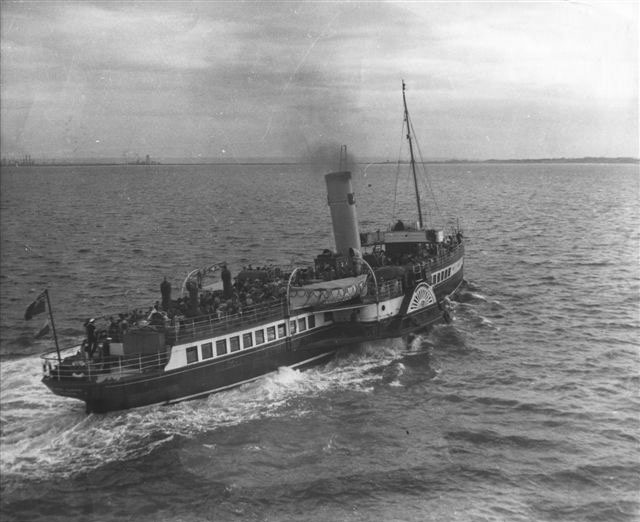
In 1947 Horsham took command of the PS Medway Queen and stayed with the ship until she finished her sailing days in 1963 after which he became a full-time Master of the GSN cargo fleet. I remember him telling me that he was mainly on the Goole to Boulogne run and when taking leave he was much nearer home in Boulogne than when going ashore and having to travel from Goole in Yorkshire to his home in Kent. It was the usual practice for Masters of the excursion ships to go on to the cargo service in the winter months but when the excursion ships finished completely in 1966 the Captains were integrated full-time into the GSN cargo service. Sadly Len Horsham died at the early age of 57.
It is interesting to note that the Medway Queen mainly had only two Masters during her long peacetime career: Captain Hayman from the mid 20’s to 1939 and Captain Horsham from 1947 to 1963. During the War the Medway Queen became HMS Medway Queen being taken over completely by the navy for use as a minesweeper and later as a naval training ship.
Kingswear Castle returned to service in 2023 after the first part of a major rebuild which is designed to set her up for the next 25 years running on the River Dart. The Paddle Steamer Kingswear Castle Trust is now fund raising for the second phase of the rebuild. You can read more about the rebuilds and how you can help if you can here.
John Megoran

